Do your kids want to know more about the praying mantis? You've come to the right place! Read on to discover all of these praying mantis facts for kids.

A mantis is a type of insect. Because of their prayer-like stance, they are usually known as praying mantids. Most are in are in the family Mantidae and are called Mantids.
The closest relatives of mantids are the order Blattodea (cockroaches and termites), and these two groups together are ranked as the Superorder Dictyoptera.
Physical Description
The mantis thorax consists of a prothorax, a mesothorax, and a metathorax. The prothorax consists of the head and forelegs and is the longest of the three segments.
Mantises have large triangle-shaped heads and long necks. They have 2 large, forward facing compound eyes and 3 smaller eyes in the middle of its head. The larger eyes are for detecting motion and distance. The smaller eyes are for detecting light.
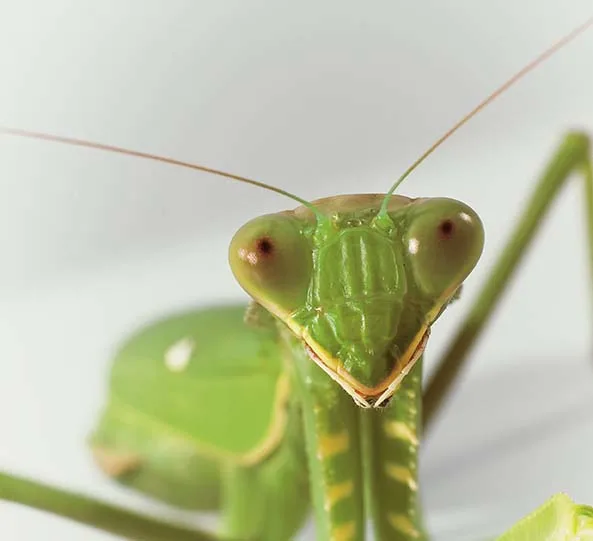
They have a beak-like snout and mandibles. They also have a pair of antennae. Mantises have highly flexible necks. Some can rotate their head a full 180 degrees. Praying mantises are usually green or brown in color which provides camouflage.
There are about 2,300 species of mantids and their sizes also vary. On average, they’re about 2 inches in length and weigh 0.009 pounds.
The smallest species of mantises are only found in Australia and is called the Bolbe pygmaea. It has an average length of only 0.39 inches. Another species from Australia, Archimantis monstrosa or the Monster Mantis, can grow up to 3.5 inches.
Mantises are either long-winged, short-winged, or wingless. The winged species, have 2 sets of wings. The outer wings act as a shield for the inner ones and also provide camouflage. The inner wings are clearer and delicate. Mantis wings develop late in life so most mantis are flightless. Mantises only fly during mating season.
Mantises have two spiked, grasping forelegs (“raptorial legs”) in which prey are caught and held securely. They’re quite good and fast jumpers. They use their front and hind legs to maintain balance while in the air. They can also change directions mid-air to jump on a specific target.
Habitat
Praying mantises are found on every continent of the world except Antarctica. They are primarily found in tropical and subtropical regions. They thrive in areas with mild winters and sufficient vegetation. This includes rainforests, grasslands, meadows, and even deserts.
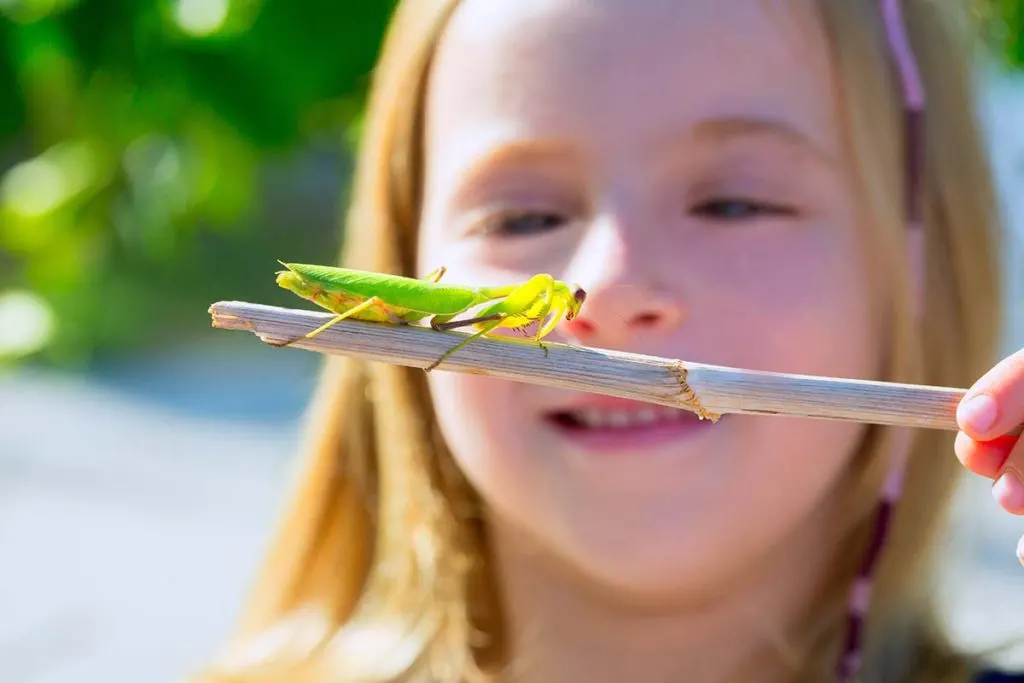
Praying Mantis Habits
Mantises are primarily diurnal which means they’re most active during the day. However, many species fly at night. Nocturnal flight is important to males in locating less-mobile females by detecting their pheromones. Flying at night exposes mantises to fewer bird predators than daytime flight would.
Mantids are masters of camouflage. Their coloring helps them blend with their environment. They not only blend with the foliage, but can mimic it, appearing as either living or withered leaves, sticks, tree bark, blades of grass, flowers, or even stones. Some species in Africa and Australia can turn black after a molt following a fire in the region to blend in with the fire damaged landscape.
Mantids are often quite aggressive towards one another. Most species are readily cannibalistic when given the opportunity.
Diet: What do Praying Mantises Eat?
Praying mantises are carnivores. They will only eat live prey, never dead remains. Their diet primarily includes crickets and grasshoppers. They also like ants, caterpillars, moths, flies, and beetles. Larger species may occasionally feed on vertebrates like lizards, frogs, small fishes, birds, snakes and rodents.
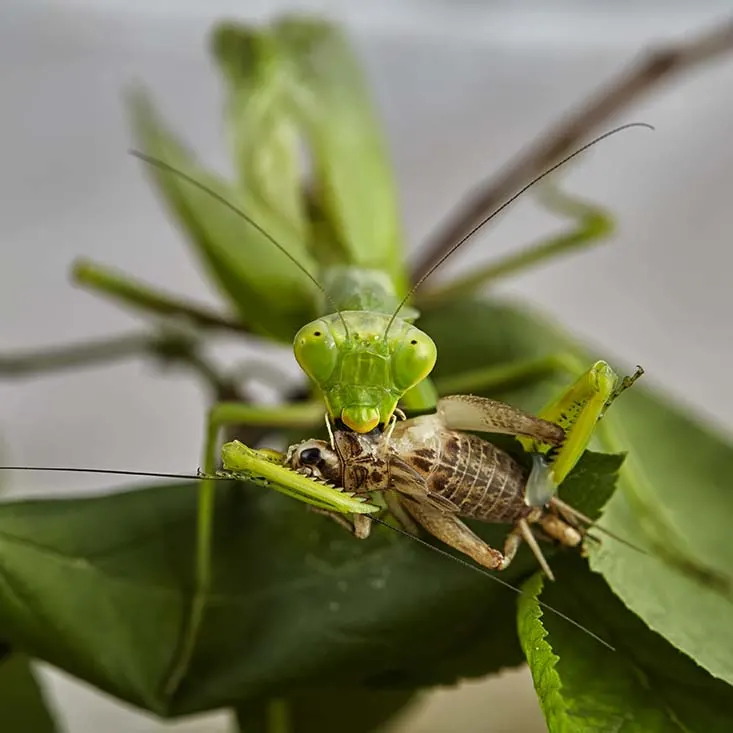
Most mantids are ambush predators, waiting for prey to come within reach. The mantis then quickly lashes out. However, some ground and bark species will pursue their prey.
Offspring
The mating season in temperate climates typically takes place in autumn. In tropical areas, mating can occur at any time of the year.
A male typically mates only once in his lifetime. About 90% of male mantises are cannibalized by the female after mating. Even if not cannibalized, most males will still die soon after mating.
Mantises go through three life stages: egg, nymph, and adult. Females can lay 10 to 400 eggs at once which are stored in a hardened protective cover called an ootheca. The ootheca is attached to a plant or buried underground. Sometimes the mother guards the ootheca against predators.
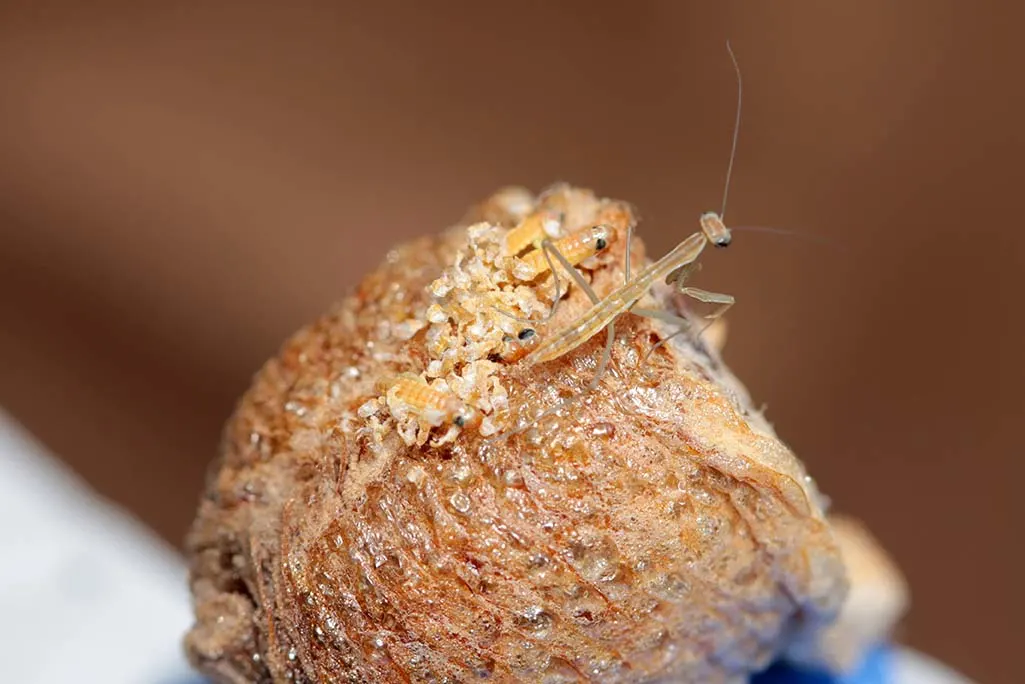
The eggs hatch after 3 to 6 weeks and emerge around springtime. Baby mantises are called nymphs. Nymphs sometimes look like ants since many predators don’t like to eat them. Nymphs molt 5 to 10 times before becoming an adult. After the final molt, most species develop wings.
Classification/Taxonomy
Kingdom: Animalia
Phylum: Arthropoda
Class: Insecta
Order: Mantodea
Family: Mantidae
Genus: Mantis
There are over 2400 different species of mantis. The European mantis has the scientific name Mantis religiosa, which literally means “praying mantis.”
History
As a species, praying mantises of one sort or another have been around since the Jurassic period, between 199.6 and 145.5 million years ago. However, they started to diversify during the Cretaceous period, 145.5 to 65.5 million years ago.
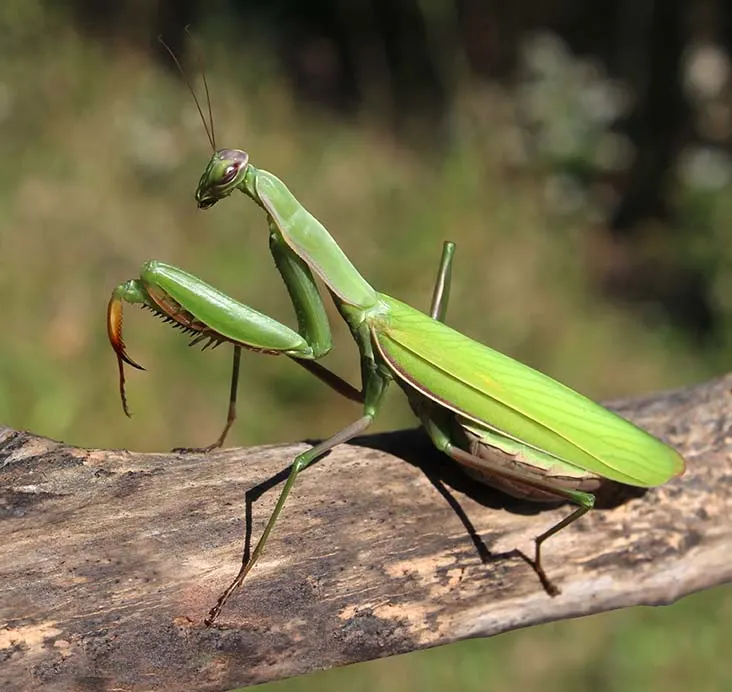
Predators
Major predators of the praying mantis are wasps, hornets, ants, frogs, bats, monkeys, larger birds, spiders, and snakes. As mentioned, larger mantises may also feed on smaller and younger mantises.
Generally, mantises protect themselves by camouflage, most species being colored to resemble foliage or other backgrounds. When threatened, many mantis species stand tall and spread their forelegs, with their wings fanning out wide to appear larger and more threatening.
Some species enhance this effect with bright colors and patterns on their hind wings and inner surfaces of their front legs. If the threat persists, a mantis may strike with its forelegs and attempt to pinch or bite.
Some species may also produce a hissing sound by expelling air. Mantises lack chemical protection, so their displays are largely bluff.
When flying at night, some mantises are able to detect the echolocation sounds produced by bats. When detected, they stop flying horizontally and begin a descending spiral toward the safety of the ground, often preceded by an aerial loop or spin.
Lifespan
Praying mantises have short lives. In the wild, smaller species only live 4 to 6 weeks. In larger species, males life expectancy is 7 to 8 months, compared to 11 to 12 months for females.
25 Unusual Facts about Praying Mantises
- Praying mantis often stand in an upright pose, with their forearms folded making it appear as if they’re in prayer.
- The Chinese Mantis, Tenodera sinensis, is one of the largest species of praying mantises, growing as long as 5 inches. The largest specimen was recorded in 1929, with a length of over 7 inches.
- The Leptocola phthisica is a big stick mantis from East Africa. They have been known to reach a length of over 10 inches.
- Most mantises get water off of plants.
- In ancient civilizations like ancient Greece, Egypt, and Mesopotamia, mantises were thought to possess supernatural powers.
- In China, the praying mantis is associated with meditation and calmness.
- Because of their prayer-like stance, they are regarded as spiritual creatures in many cultures like Christianity and Islam.
- In Japan, they are considered bad omens of impending death.
- The praying mantis was considered a god in the southern African Khoi and San tradition because of its praying posture. The word for the mantis in Afrikaans is Hottentotsgot (“god of the Khoi”).
- Mantis comes from the Greek word mantikos, meaning prophets.
- Most mantises don’t have ears. Some have just one on their belly.
- Praying mantis are the only insects with a unique stereo vision.
- Scientists are studying mantises to develop small, fast robots with good vision.
- Praying mantid are able to move quickly. The fastest praying mantid on record was able to move at a speed of 28 inches per second (730 mm/s).
- A praying mantis can leap in less than one-tenth of a second.
- Mantis bites have no venom and are not dangerous to humans.
- Chinese mantis sometimes feed on pollen.
- Female mantises may eat the head of male mantises after mating because it helps the them get sustenance during the mating process, which can be very energy-intensive.
- Like stick insects, mantises display a rocking behavior in which the insect makes rhythmic, repetitive, side-to-side movements. This rocking may replace flying or running as a source of relative motion of objects in the visual field.
- Not only can mantises see in 3-D, but research has found their 3-D vision works differently from all previously known forms in nature.
- The International Union for Conservation of Nature has listed praying mantises as a species of Least Concern which means they are not endangered.
- Flower mantises are a set of species of praying mantis that practice aggressive mimicry, which means their coloring and patterns provide camouflage by mimicking flowers.
- Most gardeners welcome praying mantises into their garden because they eat pests that hurt crops.
- Praying mantises are one of the most commonly kept insect pets.
- The Southern Praying Mantis and the Northern Praying Mantis style of martial arts developed in China are adapted from the mantis.
Check out these other cool insects!
